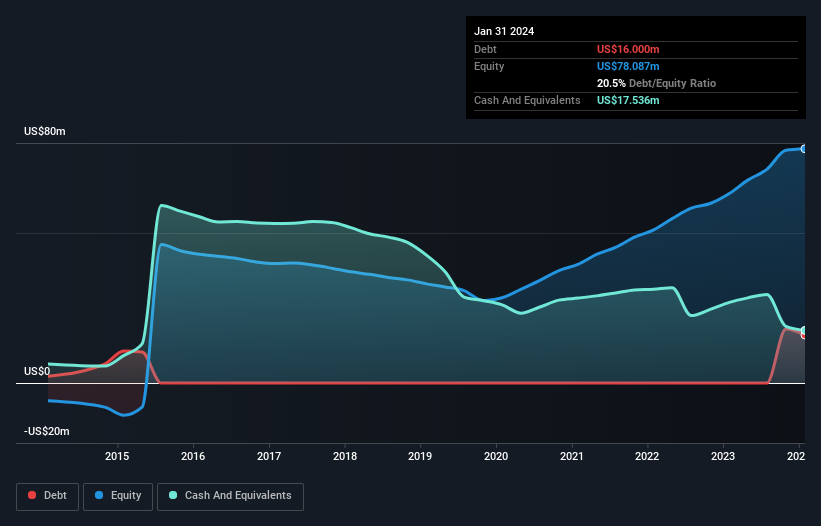Stock Analysis
- United States
- /
- Telecom Services and Carriers
- /
- NYSE:OOMA
Is Ooma (NYSE:OOMA) Using Too Much Debt?

Some say volatility, rather than debt, is the best way to think about risk as an investor, but Warren Buffett famously said that 'Volatility is far from synonymous with risk.' So it seems the smart money knows that debt - which is usually involved in bankruptcies - is a very important factor, when you assess how risky a company is. Importantly, Ooma, Inc. (NYSE:OOMA) does carry debt. But should shareholders be worried about its use of debt?
When Is Debt A Problem?
Generally speaking, debt only becomes a real problem when a company can't easily pay it off, either by raising capital or with its own cash flow. If things get really bad, the lenders can take control of the business. While that is not too common, we often do see indebted companies permanently diluting shareholders because lenders force them to raise capital at a distressed price. Having said that, the most common situation is where a company manages its debt reasonably well - and to its own advantage. The first step when considering a company's debt levels is to consider its cash and debt together.
View our latest analysis for Ooma
What Is Ooma's Net Debt?
The image below, which you can click on for greater detail, shows that at January 2024 Ooma had debt of US$16.0m, up from none in one year. However, it does have US$17.5m in cash offsetting this, leading to net cash of US$1.54m.

A Look At Ooma's Liabilities
We can see from the most recent balance sheet that Ooma had liabilities of US$51.5m falling due within a year, and liabilities of US$29.7m due beyond that. Offsetting this, it had US$17.5m in cash and US$12.1m in receivables that were due within 12 months. So its liabilities total US$51.5m more than the combination of its cash and short-term receivables.
This deficit isn't so bad because Ooma is worth US$193.0m, and thus could probably raise enough capital to shore up its balance sheet, if the need arose. However, it is still worthwhile taking a close look at its ability to pay off debt. While it does have liabilities worth noting, Ooma also has more cash than debt, so we're pretty confident it can manage its debt safely. The balance sheet is clearly the area to focus on when you are analysing debt. But ultimately the future profitability of the business will decide if Ooma can strengthen its balance sheet over time. So if you're focused on the future you can check out this free report showing analyst profit forecasts.
In the last year Ooma wasn't profitable at an EBIT level, but managed to grow its revenue by 9.5%, to US$237m. We usually like to see faster growth from unprofitable companies, but each to their own.
So How Risky Is Ooma?
Although Ooma had an earnings before interest and tax (EBIT) loss over the last twelve months, it generated positive free cash flow of US$6.1m. So although it is loss-making, it doesn't seem to have too much near-term balance sheet risk, keeping in mind the net cash. Until we see some positive EBIT, we're a bit cautious of the stock, not least because of the rather modest revenue growth. The balance sheet is clearly the area to focus on when you are analysing debt. However, not all investment risk resides within the balance sheet - far from it. Case in point: We've spotted 1 warning sign for Ooma you should be aware of.
Of course, if you're the type of investor who prefers buying stocks without the burden of debt, then don't hesitate to discover our exclusive list of net cash growth stocks, today.
Valuation is complex, but we're helping make it simple.
Find out whether Ooma is potentially over or undervalued by checking out our comprehensive analysis, which includes fair value estimates, risks and warnings, dividends, insider transactions and financial health.
View the Free AnalysisHave feedback on this article? Concerned about the content? Get in touch with us directly. Alternatively, email editorial-team (at) simplywallst.com.
This article by Simply Wall St is general in nature. We provide commentary based on historical data and analyst forecasts only using an unbiased methodology and our articles are not intended to be financial advice. It does not constitute a recommendation to buy or sell any stock, and does not take account of your objectives, or your financial situation. We aim to bring you long-term focused analysis driven by fundamental data. Note that our analysis may not factor in the latest price-sensitive company announcements or qualitative material. Simply Wall St has no position in any stocks mentioned.

Simply Wall St
About NYSE:OOMA
Ooma
Ooma, Inc. provides communications services and related technologies for businesses and consumers in the United States and Canada.
Very undervalued with excellent balance sheet.
